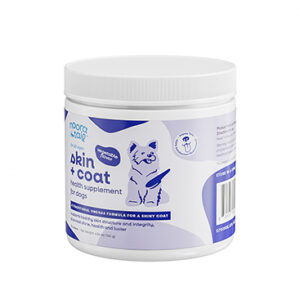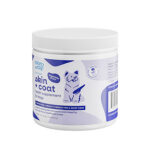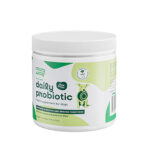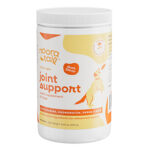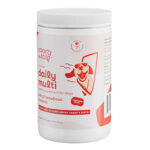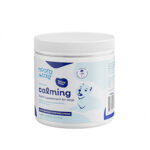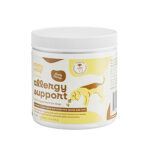Glucosamine: A Comprehensive Outline

Introduction
Glucosamine is a naturally occurring compound found in the cartilage and other connective tissues of dogs. It plays a vital role in maintaining joint health and mobility. In recent years, glucosamine has become a popular supplement for dogs with arthritis and other joint problems. This article will provide a comprehensive overview of glucosamine, including its benefits, dosage, and potential side effects.
What is Glucosamine?
Glucosamine is an amino sugar that is essential for the synthesis of glycosaminoglycans (GAGs). GAGs are long, chain-like molecules that form the main structural components of cartilage. Cartilage is the tough, flexible tissue that cushions the ends of bones and helps to reduce friction during movement.
Benefits of Glucosamine for Dogs
Glucosamine has been shown to provide several benefits for dogs with joint problems, including:
- Reduced inflammation: Glucosamine has anti-inflammatory properties that can help to reduce pain and swelling in the joints.
- Improved joint function: Glucosamine can help to improve joint mobility and flexibility, making it easier for dogs to move around.
- Protects cartilage: Glucosamine may help to protect cartilage from damage and promote its repair.
- Relieves pain: Glucosamine can help to reduce pain associated with arthritis and other joint problems.
Dosage of Glucosamine for Dogs
The recommended dosage of glucosamine for dogs varies depending on their size and weight. A general rule of thumb is to give 500-1,000 mg of glucosamine per 20 pounds of body weight. However, it is always best to consult with a veterinarian before giving your dog any supplements.
Potential Side Effects of Glucosamine for Dogs
Glucosamine is generally considered safe for dogs. However, there are a few potential side effects that you should be aware of, including:
- Gastrointestinal upset: Glucosamine can cause nausea, vomiting, and diarrhea in some dogs.
- Increased blood sugar: Glucosamine may increase blood sugar levels in diabetic dogs.
- Allergic reaction: Glucosamine can cause an allergic reaction in some dogs.
When to Give Glucosamine to a Dog
Glucosamine can be given to dogs of all ages, but it is most commonly used to treat dogs with arthritis and other joint problems. If your dog is experiencing joint pain, stiffness, or limping, talk to your veterinarian about whether glucosamine may be a good option.
Conclusion
Glucosamine is a natural supplement that can provide significant benefits for dogs with joint problems. It is important to consult with a veterinarian before giving your dog any supplements, but glucosamine is generally considered safe and effective. If you are looking for a way to help your dog move more comfortably and reduce joint pain, glucosamine may be a good option.
Introduction

Introduction
Glucosamine is a naturally occurring amino sugar found in the cartilage and joint fluid of animals. It plays a crucial role in maintaining joint health and mobility. For dogs, glucosamine can be an effective supplement for managing conditions such as arthritis, hip dysplasia, and other joint issues.
Sources of Glucosamine
Glucosamine can be obtained from a variety of sources, both natural and synthetic.
- Natural sources: Glucosamine is naturally found in animal tissues, such as bone marrow, cartilage, and tendons. Seafood shells, particularly crab and shrimp shells, are also rich sources of glucosamine.
- Synthetic sources: Synthetic glucosamine is produced in laboratories and is often used in supplements. It provides the same benefits as natural glucosamine but may have a higher absorption rate.
Benefits of Glucosamine for Dogs
Supplementing dogs with glucosamine offers several benefits for their joint health:
- Supports cartilage production: Glucosamine stimulates the production of glycosaminoglycans (GAGs), which are essential components of cartilage. GAGs provide flexibility and cushioning to joints.
- Reduces inflammation: Glucosamine has anti-inflammatory properties that help reduce pain and swelling associated with arthritis and other joint conditions.
- Improves mobility: By reducing inflammation and supporting cartilage production, glucosamine can improve a dog’s mobility and range of motion.
- Promotes joint lubrication: Glucosamine helps maintain the viscosity of joint fluid, which lubricates joints and facilitates movement.
Recommended Dosage
The recommended dosage of glucosamine for dogs varies depending on their weight and the severity of their joint condition. It is generally recommended to administer glucosamine along with chondroitin sulfate, another joint-supporting supplement.
- Dogs up to 25 pounds: 500-1,000 mg of glucosamine and 400-800 mg of chondroitin daily
- Dogs 26-50 pounds: 1,000-1,500 mg of glucosamine and 800-1,200 mg of chondroitin daily
- Dogs over 50 pounds: 1,500-2,000 mg of glucosamine and 1,200-1,600 mg of chondroitin daily
Choosing a Glucosamine Supplement
When choosing a glucosamine supplement for your dog, consider the following factors:
- Purity: Choose supplements that contain high-quality, pure glucosamine. Avoid supplements with artificial fillers or sweeteners.
- Potency: Look for supplements that provide a sufficient dosage of glucosamine for your dog’s weight and condition.
- Form: Glucosamine is available in various forms, including tablets, capsules, and powders. Choose a form that is easy for your dog to ingest.
Safety Considerations
Glucosamine is generally safe for dogs when used as directed. However, certain precautions should be taken:
- Consult a veterinarian: Before giving your dog glucosamine, always consult with your veterinarian, especially if your dog has any underlying health conditions or is taking other medications.
- Monitor for side effects: Some dogs may experience mild side effects, such as stomach upset or diarrhea. If you notice any side effects, discontinue use and consult a veterinarian.
- Avoid in certain conditions: Glucosamine may not be suitable for dogs with diabetes or shellfish allergies.
Conclusion
Glucosamine is a valuable supplement that can support canine joint health and mobility. By providing a source of essential amino sugars, glucosamine promotes cartilage production, reduces inflammation, and improves joint lubrication. When used in conjunction with a veterinarian’s recommendation and a high-quality supplement, glucosamine can help your dog enjoy a more active and pain-free life.
Metabolism and Function

Glucosamine is a naturally occurring amino sugar that plays a crucial role in joint health and mobility. It is a key component of glycosaminoglycans (GAGs), which are complex sugars that form the matrix of cartilage, the connective tissue that cushions and supports the joints.
Metabolism of Glucosamine
Glucosamine is synthesized in the body by a series of enzymatic reactions. It is derived from glucose, a primary source of energy for cells. Once synthesized, glucosamine is converted to N-acetylglucosamine (NAG), which is then incorporated into GAGs.
Function of Glucosamine in Cartilage Synthesis
GAGs, along with collagen, provide cartilage with its unique properties:
- Shock absorption: GAGs absorb impact and provide a cushioning effect for the joints.
- Lubrication: GAGs help to lubricate the joint surfaces, reducing friction and wear and tear.
- Nutrition: GAGs transport nutrients to cartilage cells.
Glucosamine is essential for the production of GAGs. It acts as a precursor for NAG, the building block of GAGs. Without sufficient glucosamine, cartilage synthesis is impaired, leading to a weakening of the joint structure.
Glucosamine and Joint Pain and Inflammation
Joint pain and inflammation are common problems in dogs, especially as they age. Glucosamine has been shown to have beneficial effects on joint health:
- Pain reduction: Glucosamine inhibits the production of inflammatory mediators, such as prostaglandins, which contribute to joint pain.
- Anti-inflammatory: Glucosamine has anti-inflammatory properties that help to reduce swelling and pain in the joints.
- Cartilage protection: By promoting cartilage synthesis, glucosamine helps to maintain healthy joint structure and prevent further damage.
Benefits of Glucosamine Supplementation
Glucosamine supplementation can be beneficial for dogs with joint issues, such as:
- Arthritis
- Hip dysplasia
- Elbow dysplasia
- Osteoarthritis
Studies have shown that glucosamine supplementation can reduce pain and stiffness, improve mobility, and slow down the progression of joint damage.
Recommended Dosage and Administration
The recommended dosage of glucosamine for dogs varies depending on their size and condition. It is generally recommended to give 500-1500 mg of glucosamine per day for small dogs and 1500-2500 mg per day for large dogs. Glucosamine supplements are typically given orally in tablet or powder form.
Safety Considerations
Glucosamine is generally safe for dogs, but it is important to consult with your veterinarian before giving them any supplements. Glucosamine may interact with certain medications, such as blood thinners. Dogs with shellfish allergies should not be given glucosamine supplements, as they may contain shellfish components.
Conclusion
Glucosamine plays a vital role in joint health by supporting cartilage synthesis and reducing inflammation. Glucosamine supplementation can be a valuable tool for managing joint pain and improving mobility in dogs with joint issues. By understanding the metabolism and function of glucosamine, dog owners can make informed decisions about their pets’ joint care. However, it is always recommended to consult with a veterinarian before giving any supplements to your dog.
Clinical Uses

Introduction
Glucosamine is a natural compound that is found in the cartilage of animals and humans. It is an important component of the cartilage matrix, which helps to give cartilage its strength and resilience. Glucosamine supplements are commonly used to treat osteoarthritis and rheumatoid arthritis in dogs.
Clinical Uses of Glucosamine
Osteoarthritis
Osteoarthritis (OA) is a degenerative joint disease that is characterized by the breakdown of cartilage. This can lead to pain, stiffness, and lameness. Glucosamine has been shown to be effective in reducing pain and improving function in dogs with OA.
Rheumatoid arthritis
Rheumatoid arthritis (RA) is an autoimmune disease that causes inflammation of the joints. This can lead to pain, swelling, and stiffness. Glucosamine has been shown to be effective in reducing inflammation and improving function in dogs with RA.
Mechanism of Action
The exact mechanism of action of glucosamine is not fully understood. However, it is thought to work by:
- Stimulating the production of new cartilage
- Inhibiting the breakdown of cartilage
- Reducing inflammation
Clinical Studies
Numerous clinical studies have investigated the efficacy of glucosamine for treating OA and RA in dogs. The results of these studies have been mixed, but some have shown positive results.
A study published in the journal Veterinary Medicine and Animal Science found that glucosamine was effective in reducing pain and improving function in dogs with OA. The study participants received either glucosamine or a placebo for 8 weeks. The dogs that received glucosamine had significantly less pain and improved function compared to the dogs that received the placebo.
Another study, published in the journal Journal of the American Veterinary Medical Association, found that glucosamine was effective in reducing inflammation and improving function in dogs with RA. The study participants received either glucosamine or a placebo for 12 weeks. The dogs that received glucosamine had significantly less inflammation and improved function compared to the dogs that received the placebo.
Safety and Side Effects
Glucosamine is generally considered to be safe for dogs. However, it can cause side effects, such as:
- Gastrointestinal upset
- Diarrhea
- Vomiting
- Allergic reactions
Dosage
The recommended dosage of glucosamine for dogs is 500-1,000 mg per day. It is important to follow the dosage instructions on the product label.
Conclusion
Glucosamine is a promising supplement for treating OA and RA in dogs. It has been shown to be effective in reducing pain, inflammation, and improving function. However, more research is needed to confirm the long-term efficacy and safety of glucosamine for these conditions.
Efficacy Studies

Glucosamine, a naturally occurring sugar molecule, has gained popularity as a joint supplement for dogs suffering from conditions such as osteoarthritis and hip dysplasia. It is believed to support joint health by providing the building blocks necessary for cartilage production. However, scientific evidence regarding its efficacy remains subject to debate.
Efficacy Studies
Several studies have reported positive results in reducing pain and stiffness associated with joint disease in dogs.
- A study published in the journal “Veterinary Surgery” found that dogs with osteoarthritis who received glucosamine supplementation experienced significant improvements in lameness, pain, and joint range of motion.
- Another study in the “Journal of the American Veterinary Medical Association” showed that glucosamine-chondroitin supplements reduced pain and improved mobility in dogs with hip dysplasia.
Controversies Regarding Long-Term Effectiveness
Despite these promising results, the long-term effectiveness of glucosamine remains a topic of controversy.
- Some studies suggest that glucosamine’s effects may diminish over time. A study in the journal “BMC Veterinary Research” found that while glucosamine initially improved pain and function in dogs with osteoarthritis, these benefits were not sustained after 18 months of treatment.
- Other studies have questioned the quality of research supporting glucosamine’s efficacy. A review published in the journal “Veterinary Record” concluded that the evidence for glucosamine’s use in dogs with joint disease is inconsistent and inconclusive.
Factors to Consider
The following factors should be considered when evaluating the potential efficacy of glucosamine for dogs:
- Severity of Joint Disease: Glucosamine’s effects may be more pronounced in dogs with mild to moderate joint disease.
- Duration of Treatment: Some studies suggest that glucosamine may take several weeks to several months to show noticeable benefits.
- Supplement Quality: The purity and potency of glucosamine supplements can vary. Choose supplements from reputable manufacturers that meet industry standards.
- Consultation with a Veterinarian: Before starting glucosamine supplementation, consult with your veterinarian to determine the appropriate dosage, duration of treatment, and potential risks.
Conclusion
While glucosamine has shown promise as a joint supplement for dogs, its long-term effectiveness remains a subject of debate. The evidence supporting its use is mixed, and the results may vary depending on individual factors.
If you are considering giving glucosamine to your dog, it is important to consult with your veterinarian and discuss the potential benefits and risks. A personalized approach that considers the dog’s specific condition and other factors, such as overall health and lifestyle, is crucial to ensure safe and effective supplementation.
Safety Concerns
Glucosamine is a popular supplement for dogs, often used to support joint health and mobility. While generally considered safe, there are potential side effects and contraindications that pet owners should be aware of before giving their furry friends this supplement.
Potential Side Effects
The most common side effects of glucosamine in dogs include:
- Gastrointestinal upset: Glucosamine can cause stomach problems such as nausea, vomiting, and diarrhea.
- Allergic reactions: Although rare, some dogs may have allergic reactions to glucosamine, which can manifest as skin irritation, hives, or respiratory distress.
- Increased water intake: Glucosamine can increase thirst, leading to more frequent urination.
- Liver toxicity: In high doses or with prolonged use, glucosamine may have a negative impact on the liver.
Contraindications
Glucosamine should not be given to all dogs. It is contraindicated in certain cases, including:
- Dogs with shellfish allergies: Glucosamine is derived from shellfish, so dogs with allergies should avoid it.
- Dogs with diabetes: Glucosamine can interfere with insulin regulation, potentially worsening diabetes symptoms.
- Dogs with bleeding disorders: Glucosamine may have blood-thinning effects, which could increase the risk of bleeding in dogs with clotting problems.
- Dogs taking certain medications: Glucosamine can interact with certain medications, such as blood thinners, antibiotics, and chemotherapy drugs.
Other Considerations
In addition to the potential side effects and contraindications, there are other factors to consider when giving glucosamine to dogs:
- Purity and quality: Ensure that you are purchasing glucosamine supplements from reputable sources that provide clear information about the product’s purity and quality.
- Dosage: Follow the recommended dosage instructions carefully and do not exceed the advised amount.
- Monitoring: Observe your dog for any side effects or changes in behavior while taking glucosamine. If you notice any concerns, stop the supplement and consult your veterinarian.
Conclusion
Glucosamine can be a beneficial supplement for dogs with joint health issues. However, pet owners should be aware of the potential side effects and contraindications associated with its use. It is crucial to consult with a veterinarian before giving your dog glucosamine, especially if they have any underlying health conditions or are taking medications. By following these guidelines, you can ensure the safe and effective use of glucosamine for your furry companion’s joint well-being.
Dosage and Administration
Glucosamine is a natural supplement commonly used to support joint health in dogs. Its ability to reduce inflammation, improve mobility, and potentially slow down the progression of degenerative joint diseases has made it a popular choice for pet owners. To ensure optimal effectiveness and safety, it’s crucial to follow the recommended dosage and administration guidelines.
Recommended Doses
The appropriate dosage of glucosamine for dogs varies depending on their weight, age, and specific health condition. However, general recommendations range from:
- Dogs under 25 pounds: 500 to 1,000 mg daily
- Dogs 25-50 pounds: 1,000 to 1,500 mg daily
- Dogs over 50 pounds: 1,500 to 2,000 mg daily
Canine Arthritis
For dogs with arthritis, higher doses of glucosamine may be necessary. Veterinarians often recommend 2,000 mg to 4,000 mg daily, depending on the severity of the condition.
Timing and Duration of Treatment
Glucosamine is typically given orally in capsule or tablet form, once or twice a day. It’s recommended to administer it with food to minimize any potential digestive upset.
The duration of treatment depends on the individual dog’s needs and response to the supplement. For dogs with acute conditions, a shorter course of treatment (4-6 weeks) may be sufficient to relieve symptoms. For chronic conditions like arthritis, long-term administration (up to 12 weeks or more) is often necessary to see significant results.
Loading Dose
In some cases, a “loading dose” of glucosamine may be prescribed by a veterinarian. This involves administering a higher dose of the supplement for a short period, such as 2-3 times the daily dose, for the first week or two. This helps to quickly build up glucosamine levels in the body, providing faster relief for severe symptoms.
Important Considerations
- Glucosamine should not be given to dogs with known allergies to shellfish.
- If your dog experiences any adverse effects, such as vomiting, diarrhea, or skin irritation, stop administering the supplement and consult your veterinarian.
- Glucosamine may interact with certain medications, including blood thinners.
- Always consult with your veterinarian before giving any supplements to your dog, including glucosamine.
Conclusion
Glucosamine can be a beneficial supplement for dogs with joint health issues. By following the recommended dosage and administration guidelines, you can ensure your furry friend receives the optimal benefits while minimizing any potential risks. Remember to consult with your veterinarian regularly to monitor your dog’s progress and adjust the treatment plan as needed.
Interactions with Medications
Glucosamine is a popular dietary supplement used to support joint health in humans and animals, including dogs. While it is generally considered safe, there are potential interactions with certain medications that must be considered. This article will discuss the interactions between glucosamine and two specific medications: warfarin and insulin.
Warfarin
Warfarin is an anticoagulant medication commonly used to prevent and treat blood clots. Glucosamine has been shown to interact with warfarin, potentially increasing its anticoagulant effects. This can increase the risk of bleeding complications.
Mechanism of Interaction: Glucosamine is believed to enhance the absorption of warfarin in the digestive tract. This increased absorption leads to higher levels of warfarin in the bloodstream, which can increase its anticoagulant activity.
Consequences of Interaction: Excessive anticoagulation can lead to bleeding complications, ranging from minor bruising to life-threatening internal bleeding. In dogs, the most common signs of warfarin toxicity include bruising, bleeding gums, nosebleeds, and bloody stools or urine.
Precautions:
- Avoid giving glucosamine to dogs taking warfarin.
- If glucosamine is necessary, monitor your dog closely for signs of bleeding and consult with your veterinarian immediately if any are observed.
- Have your dog’s blood clotting monitored regularly while taking warfarin and glucosamine together.
- Do not give glucosamine to dogs with a history of bleeding disorders or who are taking other anticoagulant medications.
Insulin
Insulin is a hormone that regulates blood sugar levels. Glucosamine has been shown to have variable effects on insulin metabolism, which can impact blood sugar control in both humans and dogs.
Mechanism of Interaction: Glucosamine may decrease the effectiveness of insulin in lowering blood sugar levels. This is attributed to its potential to inhibit the absorption of insulin in the digestive tract and increase insulin degradation in the liver.
Consequences of Interaction: Decreased insulin effectiveness can lead to higher blood sugar levels, particularly in diabetic individuals. In dogs, poorly controlled diabetes can lead to various health complications, including weight loss, increased thirst and urination, and cataracts.
Precautions:
- Monitor your dog’s blood sugar levels closely if giving glucosamine with insulin.
- Adjust insulin dosage as needed based on blood sugar readings.
- Consider using a different joint supplement if glucosamine is interfering with insulin metabolism.
- Do not give glucosamine to diabetic dogs who are not well-controlled on insulin therapy.
Other Important Considerations:
- Always consult with your veterinarian before giving glucosamine to a dog, especially if they are taking any medications.
- Use only high-quality glucosamine supplements from reputable manufacturers.
- Follow the recommended dosage instructions carefully.
- Be aware that glucosamine can take several weeks to provide noticeable benefits for joint health.
- Glucosamine should not be given to dogs with shellfish allergies.
Conclusion:
Glucosamine can be a beneficial supplement for dogs with joint problems. However, it is crucial to be aware of its potential interactions with other medications, such as warfarin and insulin. By following the precautions outlined in this article, you can help ensure the safe and effective use of glucosamine for your dog.
Other Considerations
Comparison with Chondroitin Sulfate
Glucosamine is often used in conjunction with chondroitin sulfate, another joint-supporting supplement. Chondroitin sulfate is a natural component of cartilage that helps to retain water and elasticity. While both supplements work independently to support joint health, studies have shown that they may be even more effective when used together.
Glucosamine vs. Chondroitin Sulfate:
- Glucosamine: Promotes cartilage synthesis and may reduce joint pain and stiffness.
- Chondroitin Sulfate: Retains water and elasticity in cartilage, providing cushioning and shock absorption.
Role of Diet and Exercise
Proper nutrition and regular exercise play crucial roles in maintaining joint health in dogs.
Diet:
- Feed a high-quality diet with appropriate protein and fat content to support overall joint health.
- Consider adding omega-3 fatty acids, found in fish oil, to reduce inflammation and support joint mobility.
- Avoid feeding your dog a diet high in processed or sugary foods, as these can contribute to inflammation.
Exercise:
- Regular, moderate exercise can strengthen muscles and tendons around the joints, providing stability and reducing pain.
- Gradually increase exercise intensity and duration to avoid putting excessive stress on the joints.
- Use a harness instead of a collar when walking or running your dog to prevent neck strain.
Other Important Considerations:
- Dosage: The appropriate dosage of glucosamine for dogs depends on their weight and condition. Consult with your veterinarian for a personalized recommendation.
- Side Effects: Glucosamine is generally safe for dogs, but it may cause stomach upset or diarrhea in some cases.
- Drug Interactions: Glucosamine may interact with certain medications, such as blood thinners and diabetes medications. Inform your veterinarian of any medications your dog is taking before giving them glucosamine.
- Choosing a Supplement: Choose a high-quality glucosamine supplement with a guaranteed purity and potency. Look for products with the National Animal Supplement Council (NASC) seal of approval.
Conclusion
Glucosamine is a valuable supplement that can support joint health in dogs. When used in conjunction with chondroitin sulfate, proper nutrition, and regular exercise, glucosamine can help reduce pain and stiffness, improve mobility, and maintain the overall well-being of your furry companion. Always consult with your veterinarian before giving your dog any supplements, including glucosamine.










